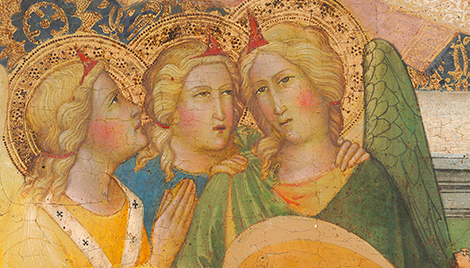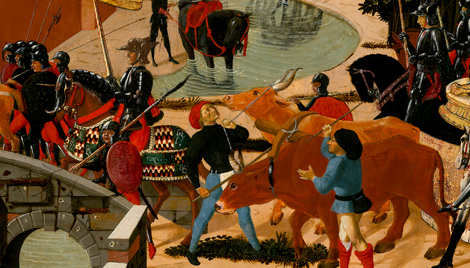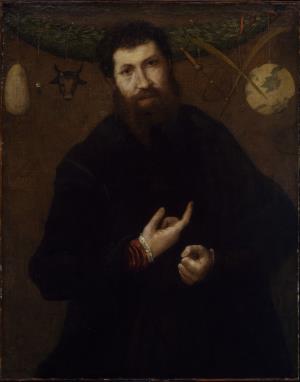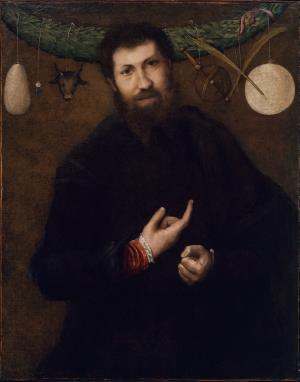Portrait of a Man with Allegorical Symbols
Portrait of a Man with Allegorical Symbols
- Artist
- Lorenzo Lotto
- Artist Dates
- c. 1480-1556/1557
- Artist Nationality
- Italian
- Title
- Portrait of a Man with Allegorical Symbols
- Date
- early to mid 1540s
- Medium
- oil on canvas
- Dimensions
- 101 x 80 cm (39-3/4 x 31-1/2 in)
- K Number
- K2075
- Repository
- El Paso Museum of Art
- Accession Number
- 1961.1.30
- Notes
Provenance
Sir J. Charles Robinson [1824-1913], Swanage, England, 1910. [1] A. W. Spender, Vevey, Switzerland, before 1940. [2] Private collection, Milan, 1953. [3] (Count Alessandro Contini Bonacossi, [1878-1955], Rome-Florence); sold to Samuel H. Kress [1863-1955] on 7 June 1954; gift to El Paso Museum of Art in 1961, no. 1961.1.30. [1] Discussed and reproduced by Herbert Cook, "Venetian Portraits, and Some Problems," Burlington Magazine 16, no. 84 (March 1910), p. 333. [2] Spender given as prior owner in the exhibition catalogue Four Centuries of Venetian Painting, Toledo Museum of Art, 1940, no. 37. [3] Per Luigi Coletti, Lotto, Bergamo, 1953, p. 45, no. H2.
Catalogue Entry
Lorenzo Lotto
Portrait of a Man with Allegorical Symbols
K2075
El Paso, Tex., El Paso Museum of Art (1961-6/26), since 1961.(1) Canvas. 39 3/4 x 31 1/2 in. (101 x 80 cm.). Abraded throughout. The attribution to Lotto has not been questioned. Dates suggested range from about 1525 to the early 1540s. It is with portraits painted in the latter period that K2075 seems most compatible in style.(2) The remarkable display of emblems hung across the top of the picture has been interpreted by a former owner as: half-blown bladder, poverty; pearl and sapphire, wealth; ox head, labor; armillary sphere, worldly renown; palm branches, fame; full-blown bladder, empty fame – all indicating that the sitter had run the gamut of these experiences.(3) A more likely interpretation is that, as in K303 (the Allegory painted as cover for Bishop Rossi's portrait), Lotto has here presented an allegory of the choice between good and evil, a variation of the old theme of 'Hercules at the Crossroads.'(4) The three emblems at the left would then refer to worldly or material wealth, while the three at the right would refer to immaterial assets, and the man's gesture would indicate his choice of the latter. This interpretation is rendered the more plausible by the fact that the emblem at the extreme right proves, after cleaning of the picture, to be a terrestrial globe and thus may serve, along with the armillary sphere, as a reference to cultivation of the intellect. Provenance: Sir. J. Charles Robinson, London. A. W. Spender, Vevey, Switzerland. Private Collection –exhibited: 'Four Centuries of Venetian Painting,' Toledo Museum of Art, Toledo, Ohio, Mar. 1940, no. 37 of catalogue by H. Tietze (where erroneously said to be hitherto unpublished), as Lotto. Private Collection, Milan.(6) Contini Bonacossi, Florence. Kress acquisition, 1954.
References
(1) Catalogue by F. R. Shapley, 1961, no. 26, as Lotto. (2) K2075 has been attributed to Lotto by H. Cook (in Burlington Magazine, vol. XVI, 1910, p. 333, dating it c. 1535, suggesting that it may be a self-portrait, and giving Sir J. Charles Robinson's interpretation of the emblems), A. Banti and A. Boschetto (Lorenzo Lotto, n.d. [1953], p. 90, with the date of c. 1542/45), L. Coletti (Lotto, 1953, p. 45, no. H2, preferring a date of 1527/29), B. Berenson (Lorenzo Lotto, 1956, p. 101; Italian Pictures ... Venetian School, vol. I, 1957, p. 104), and P. Bianconi (Lorenzo Lotto, vol. II, 1963, p. 89, dating it c. 1540/44). (3) See Cook, loc. cit. in note 2, above. (4) W. E. Suida (in ms. opinion) made this suggestion. (5) According to Coletti, caption to pl. 112 of op. cit. in note 2, above.








